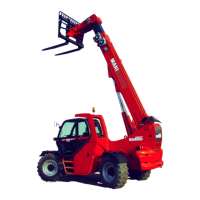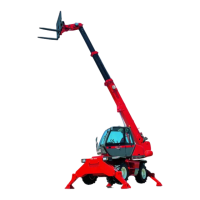1
3
MHT 10120 L M
SS
eries
The person in charge of the equipment must take these criteria into account when
assessing whether or not a person will make a suitable driver.
- Get to know the telescopic fork lift truck on the terrain where it is to be used.
- Transport the load with the boom lowered and fully retracted
- Position the forks at right-angles to theload to be lifted.
- Drive the truck at a speed appropriate to conditions and the state of the ground.
- Never go too fast or brake sharply with a load.
- When picking up a load, check that the ground is as even as possible.
- Never attempt to carry out operations which exceed the lift truck’s capabilities.
- Never raise a load in excess of the lift truck’s capacity and never increase the size of
the ballast.
- Drive around obstacles.
- Take care over electrical wires, trenches and recently-excavated or filled ground.
- Never leave the engine running unattended.
- Use the parking brake when depositing difficult loads or on sloping ground.
- Never leave the truck parked with a raised load.
- Never authorise anyone to approach or pass below a load.
- Always think of safety and only transportwell balanced loads.
- Never lift a load using one fork only.
- Drive with care and with reflexes alert.
- When the lift truck is not in use, lower the forks to the ground and engage the parking
brake.
- Never leave the ignition key in the truck unattended.
- Never leave the truck loaded on a gradient of over 15% even with the parking brake
engaged.
- When lifting a load, take care that nothing and no-one interferes with the movement
and adopt proper handling procedures only.
- Comply with the data provided in the load diagrams.
- Never transport another person on the lift truck.
Whenever an implement is changed, to prevent damage to the hydraulic unions always
proceed as follows:
- Stop the engine
- turn key to position I
- release pressure from the circuit using the joystick
Always check these pipe unions to ensure they are clean.

